by Steven J. Cary and Michael E. Toliver
Skippers (Hesperiidae). About a third of our butterfly fauna, more than 100 species, belongs to this family, which is subdivided into six subfamilies in the US: Eudaminae, Tagiadinae, Pyrrhopyginae, Pyrginae, Heteropterinae, and Hesperiinae. Of those six subfamilies, five are known from New Mexico and the sixth (Tagiadinae, represented by Celaenorrhinus fritzgaertneri) has been taken on the Arizona side of Cottonwood Canyon, Peloncillo Mountains. Therefore, it is likely that eventually all six will be known from our state. The tribe Megathymini has been considered a seventh subfamily, but recent genetic work (Li, et al, 2019) shows it belongs in the Hesperiinae. Skippers earned their name because of their rapid, skipping flight, which is powered by a heavily-muscled thorax. All skippers have antennal clubs that are distinctively bent, curved or hooked. Larvae silk leaves together for nests; larvae overwinter. Most subfamilies have distinct larval food preferences. Updated June 13, 2023
Giant Skippers (Hesperiidae: Hesperiinae: Megathymini). Giant Skippers earn their name with large size and very stout bodies. This uniquely American group is especially diverse in the Southwest because their larvae depend on Agavaceae, a group of plants that thrives and diversifies in that region’s arid and semi-arid landscapes. New Mexico has seven different giant-skipper species. Yuccas host our three Megathymus species, while agaves, or century plants, host our four Agathymus species. In all cases, larvae bore into succulent leaves, roots or stems where they feed, make shelters, and pupate. Adults are larger than other skippers and, in the case of some species, are quite elusive. Much of what we know about giant skippers was learned by scientists who, thinking outside of the box, discovered how to find larval nests, drove around in search of ‘colonized’ stands of yucca or agave, harvested colonized plants, then reared larvae through to adulthood. Giant Skippers were once treated as a distinct subfamily, the Megathyminae, but recent DNA studies revealed that they are better treated as a Tribe within the Hesperiinae. We retain the hot link here for your convenience.
- Arizona Giant-Skipper (Agathymus aryxna)
- Orange Giant-Skipper (Agathymus neumoegeni) Agathymus neumoegeni carlsbadensis, Agathymus neumoegeni judithae, Agathymus neumoegeni diabloensis
- Poling’s Giant-Skipper (Agathymus polingi)
- Mary’s Giant-Skipper (Agathymus mariae)
- Yucca Giant-Skipper (Megathymus yuccae coloradensis) Megathymus yuccae navajo, Megathymus yuccae arizonae, Megathymus yuccae reubeni, Megathymus yuccae elidaensis, Megathymus yuccae winkensis
- Ursine Giant-Skipper (Megathymus ursus) ursus violae, ursus deserti
- Viola’s Giant-Skipper (Megathymus violae)
- Strecker’s Giant-Skipper (Megathymus streckeri) Megathymus streckeri leussleri
Agathymus aryxna (Dyar) Arizona Giant-Skipper (updated May 31, 2023)
Description. Arizona Giant-Skipper resembles Orange Giant-Skipper, but it is predominantly dark above, not so orange, with only a pale orange postmedian band. They are similar below, too, but Agathymus aryxna has more prominent white spots on the hindwing costa. Range and Habitat. Arizona Giant-Skippers have a limited range in southeast Arizona, northern Mexico and southwest New Mexico (counties: Gr,Hi,Lu). They inhabit Upper Sonoran Zone savannas, usually 4700 to 7000′ elevation. Their distribution approaches that of Agathymus neumoegeni and may yet be found to overlap it in Grant or Luna counties, where care is needed to ensure proper identification. Life History. Palmer’s Agave (Agave palmeri, Agavaceae) is the preferred larval host for Arizona Giant-Skippers. Larvae build their “trapdoors” on the undersides of A. palmeri leaves; Orange Giant Skippers build their “trapdoors” on the upperside of A. parryi leaves. Flight. Arizona Giant-Skippers fly during the same season as Orange Giant-Skippers, but peaking and extending a little later. Our records span September 1 to October 24. Adults rarely seek nectar, but instead prefer to buzz and whirr around canyon mudholes and roadside puddles. In seeking electrolytes, they sometimes settle for the perspiration of butterflyers. Comments. This species is more easily photographed than most other ‘Megs.’ Ferris (1976) reported both Arizona and Orange Giant-skippers from Cherry Creek Canyon and McMillan Canyon in Grant County. Those specimens should be examined to see if this is a true point of contact between the two species.
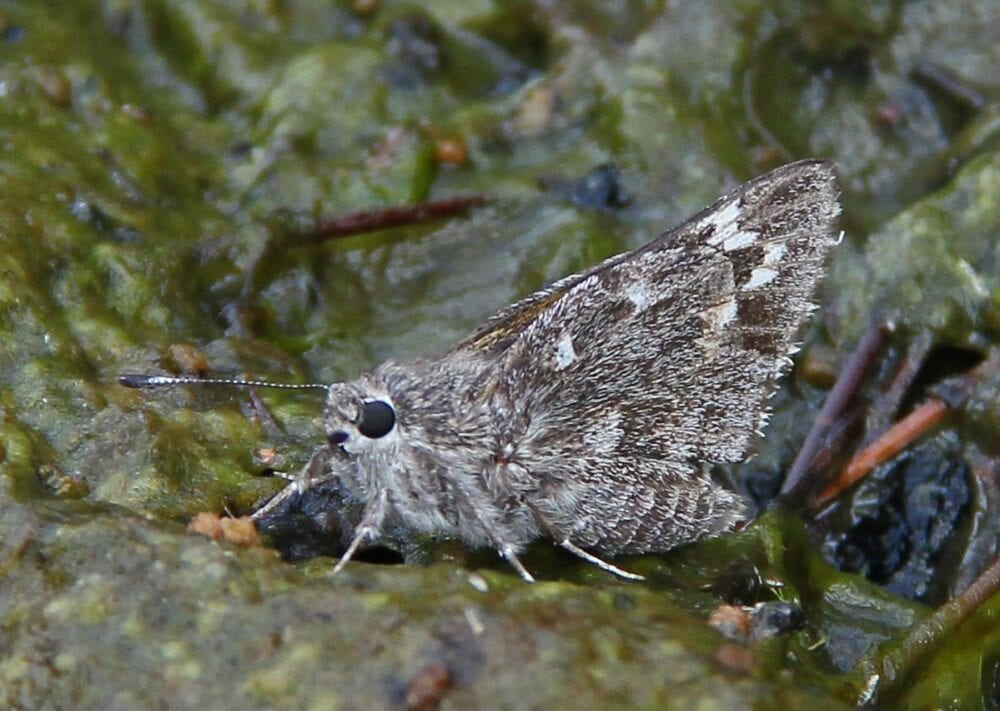
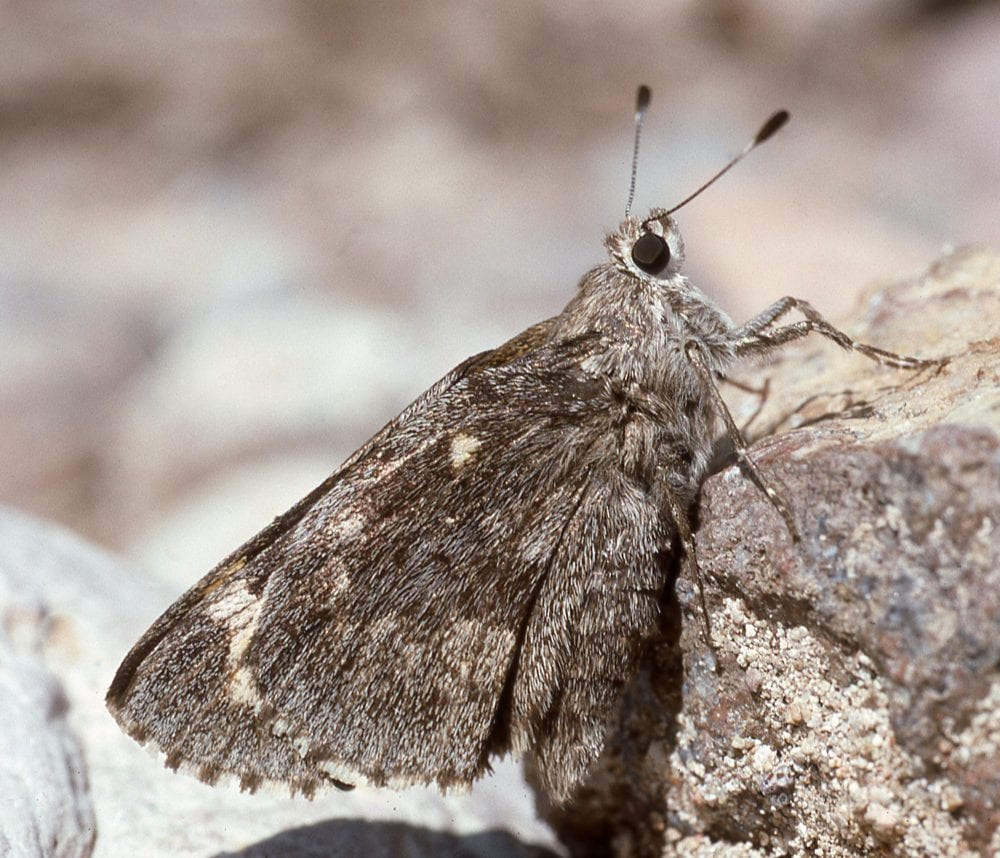

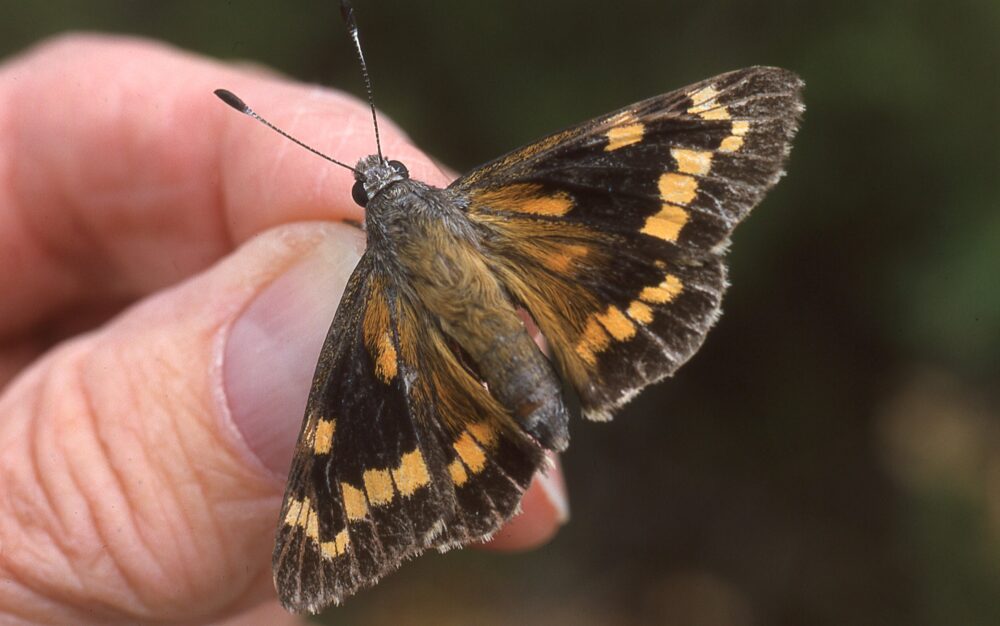
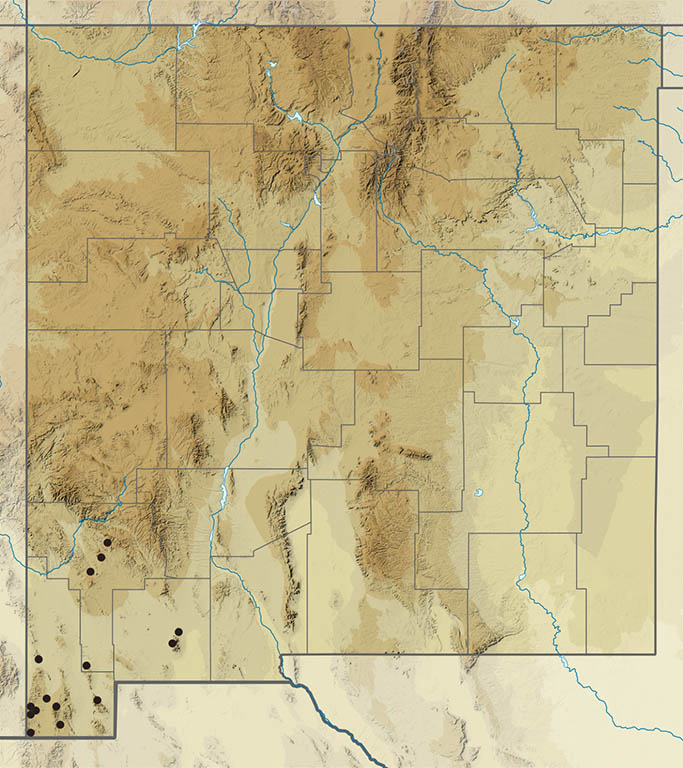
Occurrences of Arizona Giant-Skipper (Agathymus aryxna) in New Mexico.
Agathymus neumoegeni (W. H. Edwards) Orange Giant-Skipper (updated May 31, 2023)
Description. Like most Megathymines, Agathymus neumoegeni is large and stout-bodied. Adults are bright orange above with a black wing margin and black patches. Undersides are grizzled gray with vague white bands. This species can be confused with Agathymus aryxna, which is darker and has different adult behaviors. Range and Habitat. Orange Giant-Skipper lives along the Mogollon Rim in central Arizona and southwest New Mexico (subspecies Agathymus neumoegeni neumoegeni), in the mountains of southeast New Mexico and west Texas (various subspecies including Agathymus neumoegeni carlsbadensis (D. Stallings & Turner)) and in the Chisos Mountains of southwest Texas. Colonies occur within stands of the larval hosts in Upper Sonoran Zone canyons and middle elevation mountains, 4100 to 7000′ elevation. In New Mexico, this beauty lives only in the south (counties: Ca,Ch,DA,Ed,Gr,Lu,Ot). Life History. Agave parryi is the preferred larval host throughout New Mexico, but Agave lechuguilla is sometimes used (both Agavaceae). Young larvae bore into leaf tips, feed for a few weeks, then hibernate over winter. Mature larvae bore into upper sides of leaf bases and feed on sap; fecal material accumulates outside the burrow. Pupation is within the burrow, protected by a silk cap over the hole on the upperside of a leaf. Flight. Orange Giant-Skippers are univoltine and fly late in the season. New Mexico records span August 29 to October 11, peaking in late September. Unlike look-alike Arizona Giant-Skippers, male Orange Giant-Skippers patrol rocky hilltops and ridgetops, but also visit canyon mudholes. Comments. As interest in Giant Skippers developed in the 1950s and 1960s, a large number of “subspecies” were described, based on the assumption that populations in desert mountain ranges were isolated from one another. A. neumoegeni was one of the recipients of this interest. Agathymus neumoegeni carlsbadensis was described from specimens collected in Carlsbad Caverns National Park (Ed) in 1957. Agathymus neumoegeni judithae (D. Stallings & Turner 1957) was described from the Hueco Mountains of west Texas, which extend into southern Otero County, New Mexico. If judithae proves to be a valid subspecific name, it undoubtedly occurs in the NM portion of the Huecos. Agathymus neumoegeni diabloensis H. A. Freeman 1962 was described from the Sierra Diablo and Sierra Blanca Mountains just SW of the Guadalupe Mts. in Hudspeth County, TX. It seems likely that diabloensis is poorly distinguished from carlsbadensis.
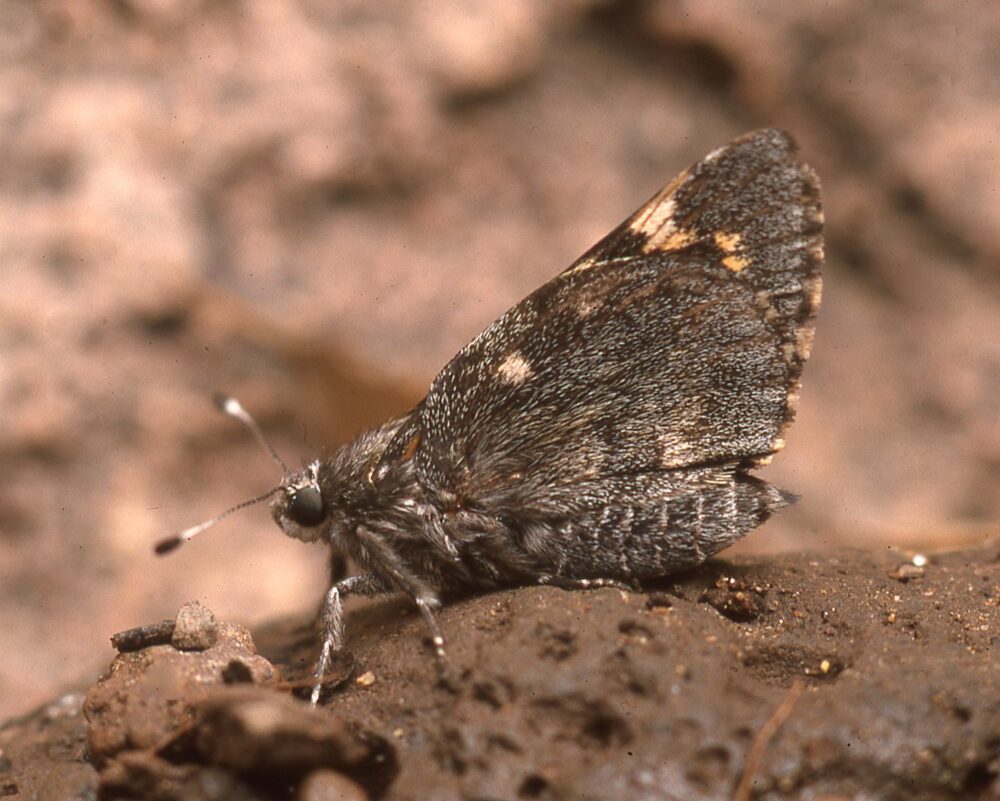
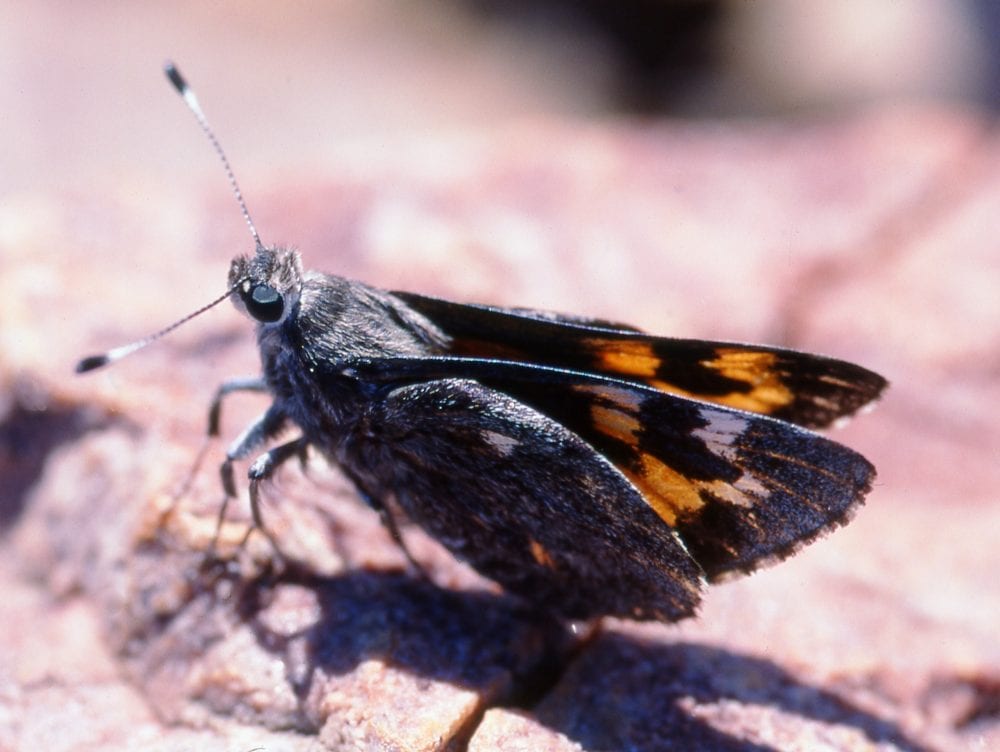
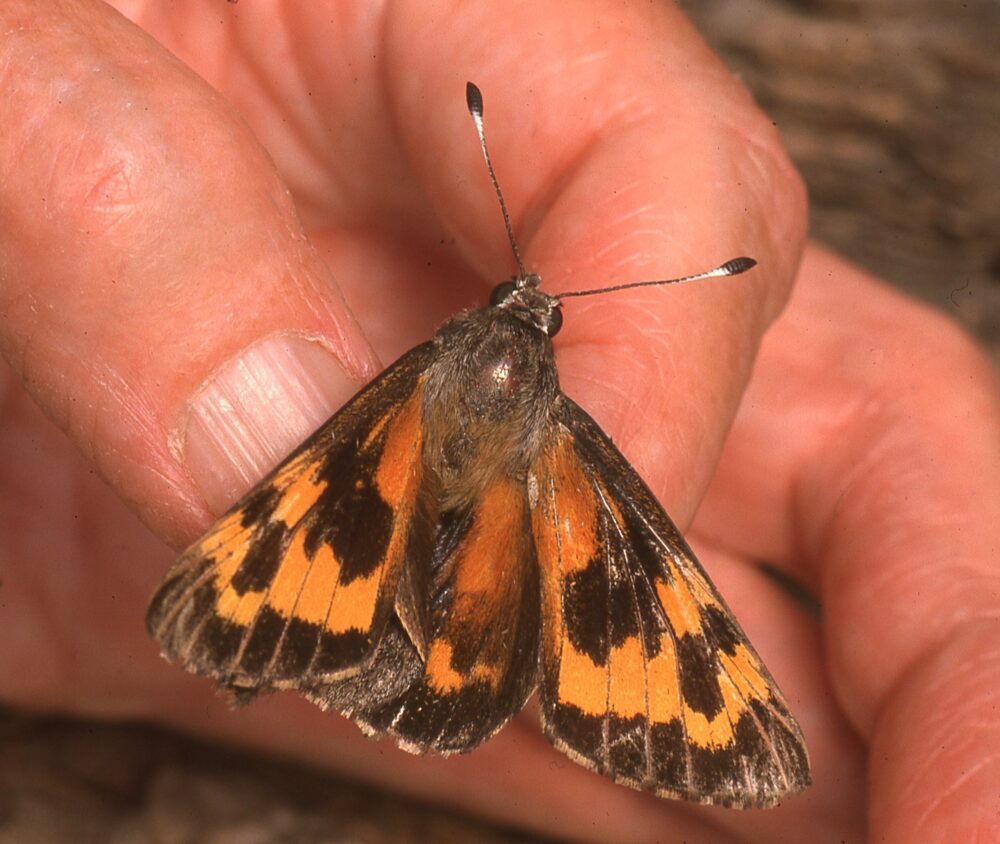
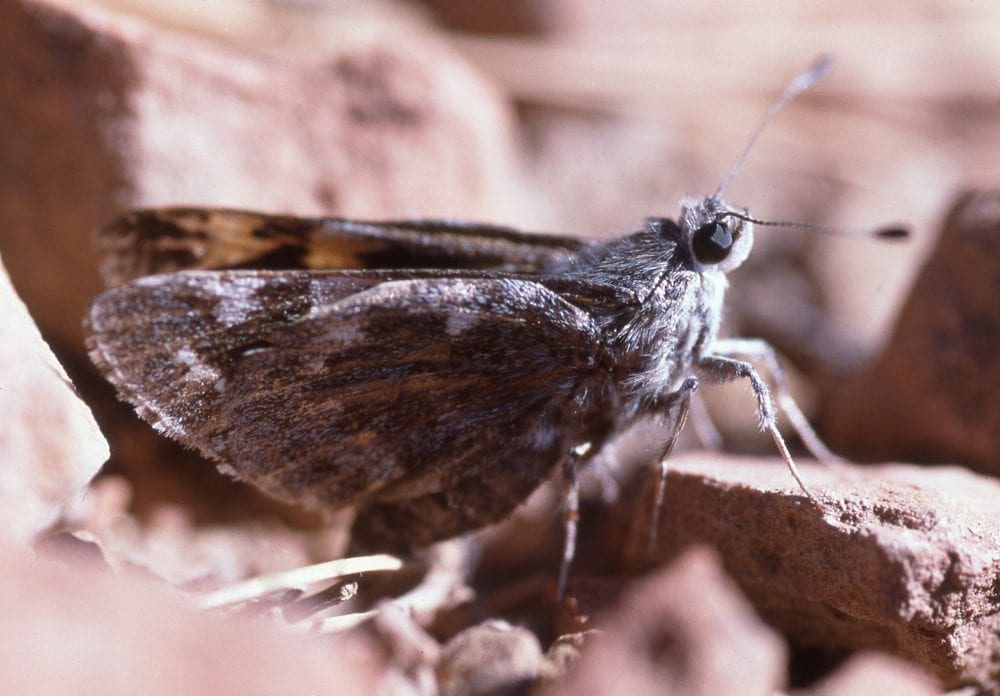
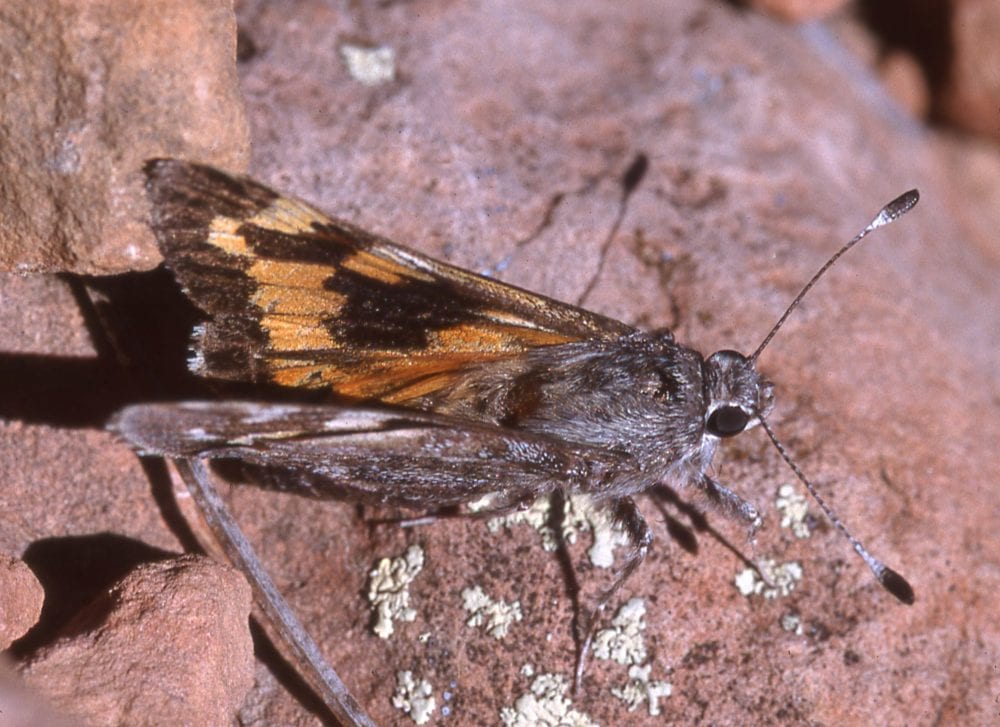

Agathymus polingi (Skinner) Poling’s Giant-Skipper (updated June 1, 2023)
Description. Poling’s Giant-Skipper is small, for a Megathymine, which helps to distinguish it from similar relatives. Dorsal patterns resemble those of Orange Giant-Skipper, but the ground color is more yellow-orange than black. As Arizona Giant Skipper is the species most likely to be found with or near Poling’s, that coloration and its size will help an observer tell them apart. Additionally, Poling’s Giant Skipper doesn’t typically visit wet spots, instead remaining close to colonies of its larval host. The hindwing underside may have prominent white bands. Range and Habitat. This butterfly’s distribution barely includes New Mexico, touching our extreme southwest corner in Guadalupe Canyon (county: Hi), 4600 to 5000’ elevation. It is more common to the south and west into Arizona and northwest Mexico. Life History. Larvae eat Agave schotti, a tiny species that grows on canyon walls. Larvae burrow into undersides of leaf bases. Colonies of this plant occur in Hidalgo and Grant counties and should be examined for this butterfly. Flight. Adults perch on canyon walls near the host plant, often head-down. The one annual generation is on the wing in autumn; our few records span October 9 to November 20. Comments. Agathymus polingi may fly concurrently with Agathymus aryxna, but its small size makes it easy to distinguish. Its name honors O. C. Poling, a prolific collector in the Southwest in the late 19th century.
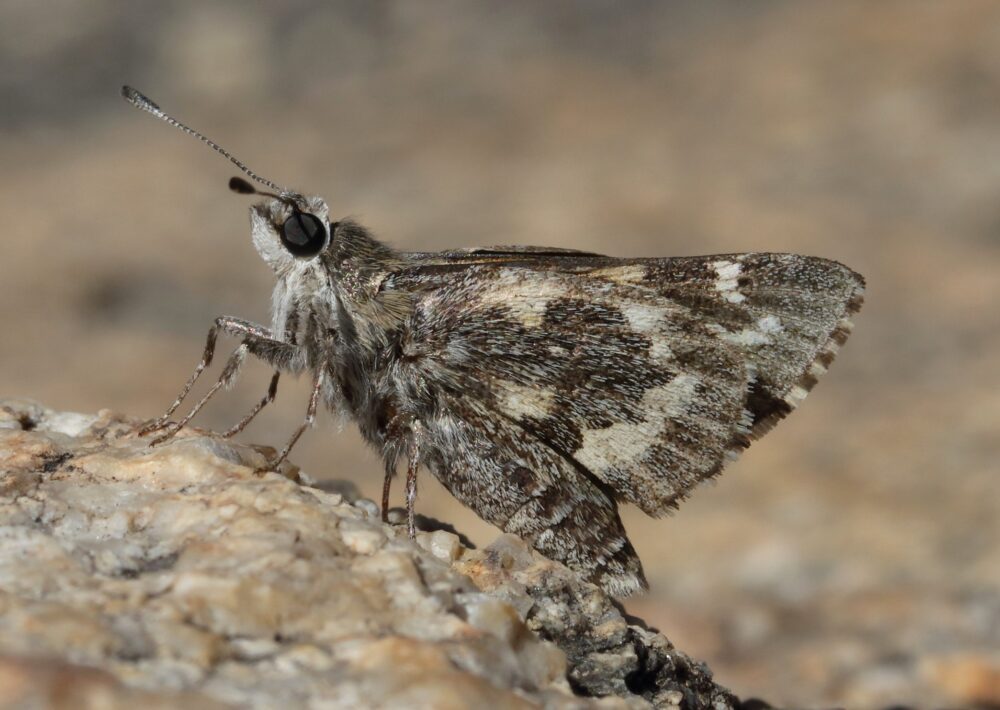
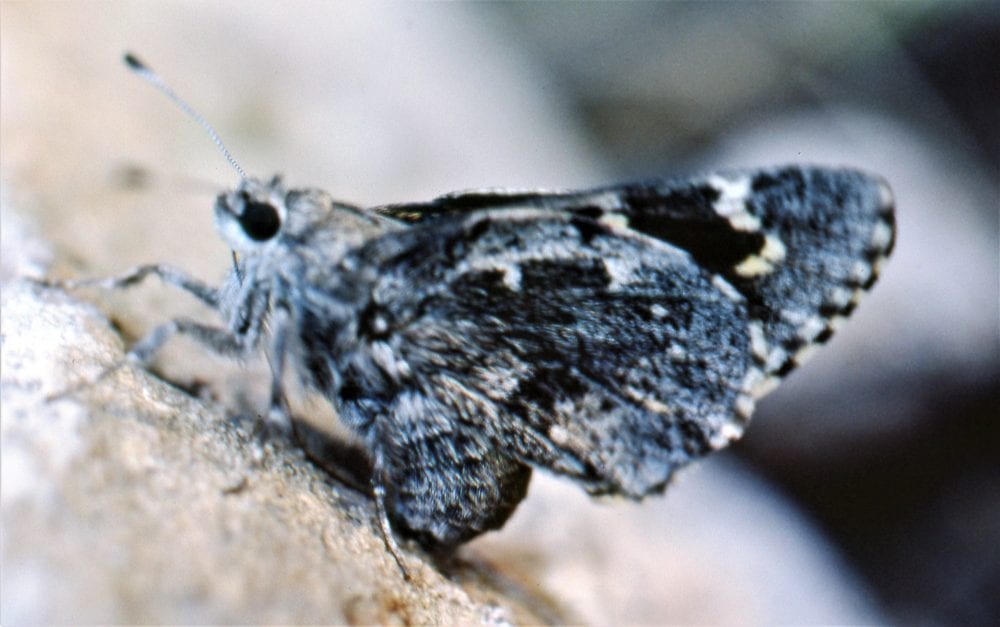

Occurrence of Poling’s Skipper (Agathymus polingi) in New Mexico.

Comparison of male Agathymus found in NM. All images: left side dorsal, right side ventral. A) Arizona Giant-skipper, A. aryxna B) Orange Giant-skipper, A. neumoegeni neumoegeni C) Mary’s Giant-skipper, A. mariae D) Poling’s Giant-skipper, A. polingi. Photos courtesy of Andy Warren.

Comparison of female Agathymus found in NM. All images; left side dorsal, right side ventral. A) Arizona Giant Skipper, A. aryxna B) Orange Giant Skipper, A. neumoegeni neumoegeni C) Mary’s Giant Skipper, A. mariae D) Poling’s Giant Skipper, A. polingi. Photos courtesy of Andy Warren.
Agathymus mariae (W. Barnes & Benjamin) Mary’s Giant-Skipper (updated June 2, 2023)
Description. Mary’s Giant-Skipper resembles Orange Giant-Skipper, with which it may be locally sympatric. It differs by being smaller and having a darker upper side with orange spots that are smaller and paler. Range and Habitat. Agathymus mariae is a denizen of southeast New Mexico (counties: Ch?,Da?,Ed,Ot), but it also occurs south well into the Chihuahuan Desert of west Texas and northeast Mexico. Look for it near the foodplant, which grows, sometimes in impenetrably dense stands, on desert flats and rocky canyon walls, usually between 4000 and 5000′ elevation. Life History. Larvae are hosted by Agave lechuguilla (aka: shindagger) (Agavaceae). Mature larvae can create tunnels linking several leaf bases. Flight. Confirmed New Mexico records for adults all indicate a flight period between September 12 and October 14. They are most often seen perching on the ground near the host. Comments. Lechuguilla occurs as far north as near Cloudcroft (Ot) and as far west as Las Cruces (DA), so Mary’s Giant Skipper undoubtedly follows the host plant and should be sought in much of south-central New Mexico. Vague reports from Chaves and Dona Ana counties need confirmation. Outings in search of Mary’s Giant-Skipper require care. The senior author still carries a lechuguilla leaf tip irretrievably embedded next to his right tibia.
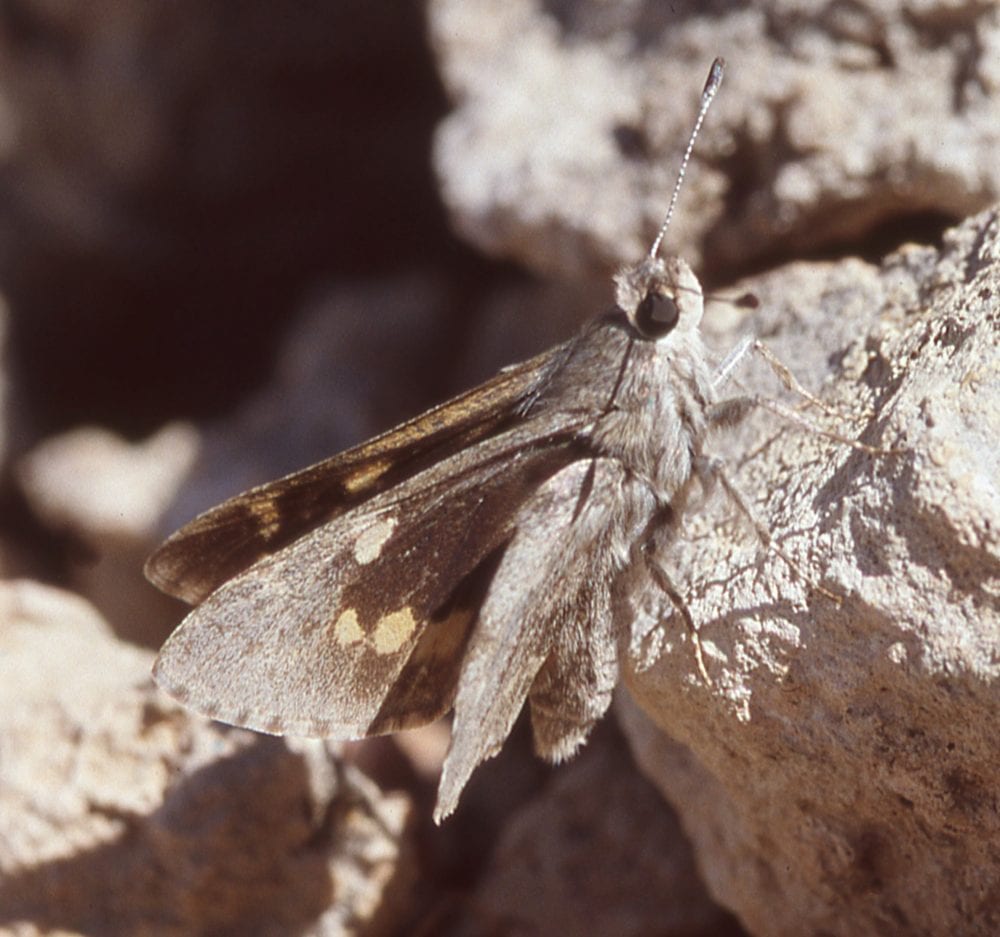

Occurrences of Mary’s Giant-Skipper (Agathymus mariae) in New Mexico. Open circles represent unconfirmed reports.
Megathymus yuccae (Boisduval & LeConte) Yucca Giant-Skipper (updated December 22, 2023)
Description. Yucca Giant-Skipper DFW is gray-black with a white to cream marginal band. A submarginal band of spots extends from the FW apex to the trailing edge. That band consists of larger spots in the female. Fringes are checkered. A series of smaller spots lines the FW costa near the end of the cell; in the female those spots are larger and contained within the cell. The DHW also is bordered by the marginal white to cream band. In the male, the DHW has a largely unmarked gray-black interior (occasionally marked with a few small cream spots in some individuals). Females have a submarginal row of cream to yellow spots, varying in size. A frosted gray underside has two (sometimes one) white spot on the hindwing costa, one about midway along the costa and the other near the apex. The VFW repeats the pattern of the upperside, often paler in color. Yucca Giant Skipper is smaller than other Megathymus. Range and Habitat. Megathymus yuccae occurs nearly coast to coast in the southern US. It occupies Upper Sonoran Zone savannas in much of New Mexico (all counties but DB,Gu,Ha,Le,SM), 4500 to 8000′ elevation. It is New Mexico’s most widespread giant-skipper. Life History. Larvae bore into stems or roots of several Yucca species (Agavaceae). Larval hosts for Megathymus yuccae include Yucca glauca in eastern New Mexico, Yucca baileyi in central New Mexico, Yucca elata in south-central New Mexico, and Yucca baccata in western New Mexico. Mature larvae enter winter and pupate in late winter. Flight. Adults fly in spring; New Mexico records span March 16 to June 21. Peak flight numbers are in March or April in southern New Mexico, shifting to May in northern New Mexico. Males establish territories in flattish, valley-bottom openings. From perches on prominent rocks or stumps, males patrol in broad, sweeping arcs, searching their domain and showing off for females. Comments. New Mexico has three different forms (subspecies) of this butterfly. Most of our populations are Megathymus yuccae coloradensis (C. Riley 1877). Megathymus yuccae navajo Skinner 1911 was described from Fort Wingate (MK) and covers many populations in Arizona and western New Mexico, including Bootheel (Hi) populations formerly termed Megathymus yuccae arizonae (Tinkham 1954). Megathymus yuccae reubeni D. Stallings, Turner & V. Stallings 1963 occupies south-central New Mexico (DA,Ed,Li,Ot,Si,So,To) and has been reared from Yucca elata. Megathymus yuccae elidaensis D. Stallings, Turner & V. Stallings 1966 was described from eastern NM (Ro) but is now considered a synonym of coloradensis. Reports of Megathymus yuccae winkensis H. Freeman 1965 (currently considered a synonym of coloradensis) from Eddy County should be examined. In fact, areas of contact between all the various subspecies require closer examination.
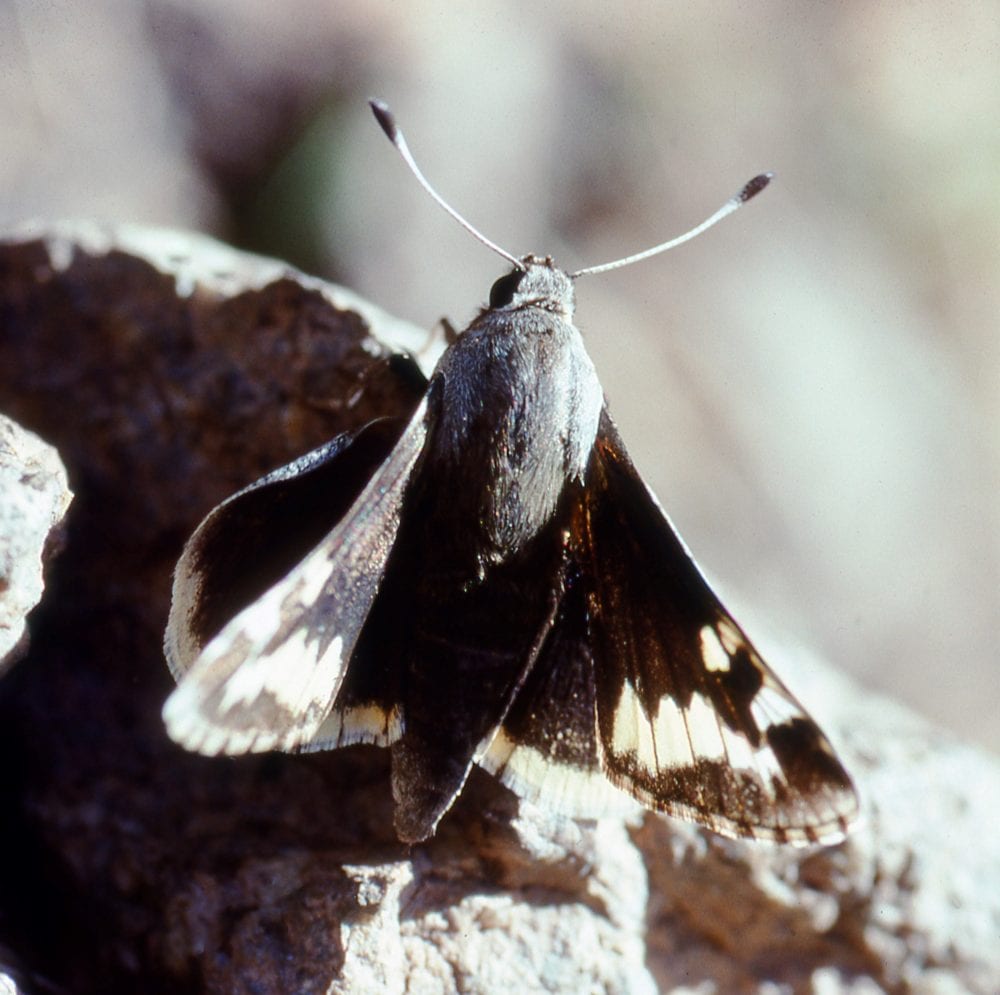
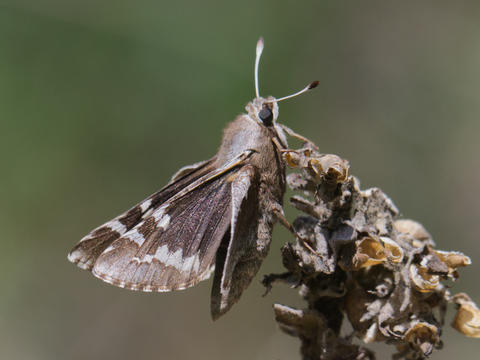
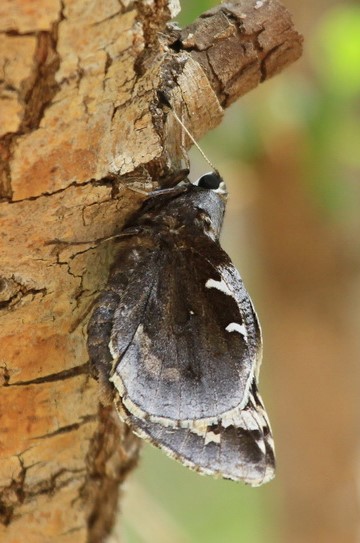
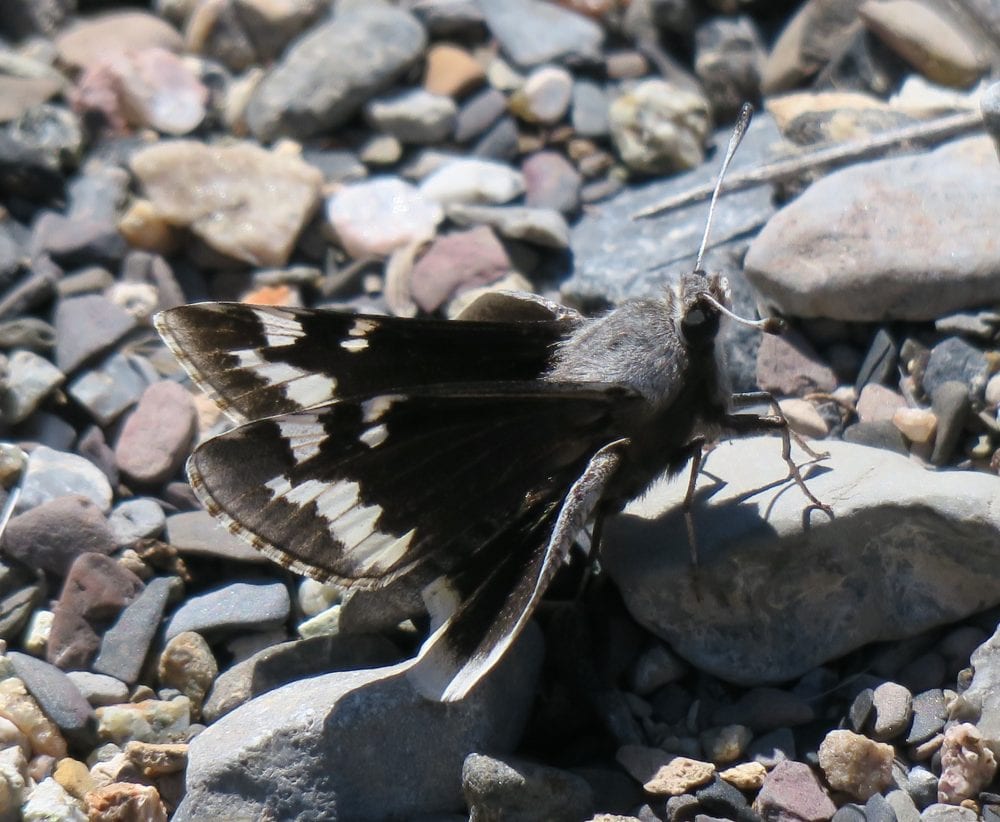
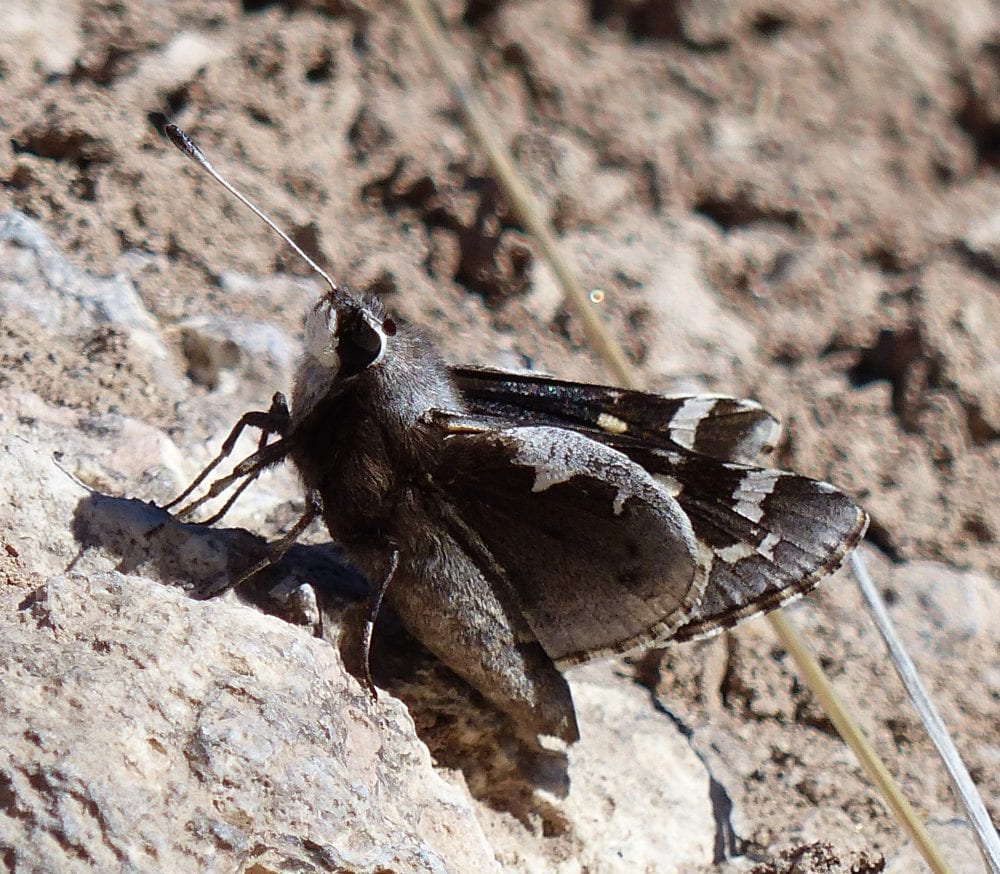
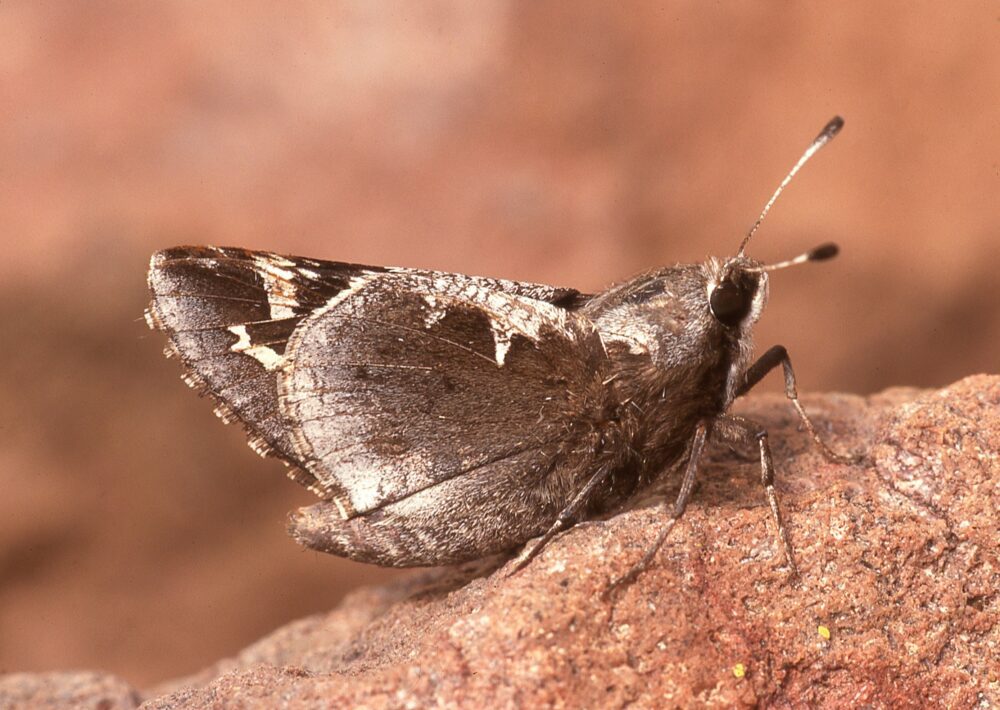
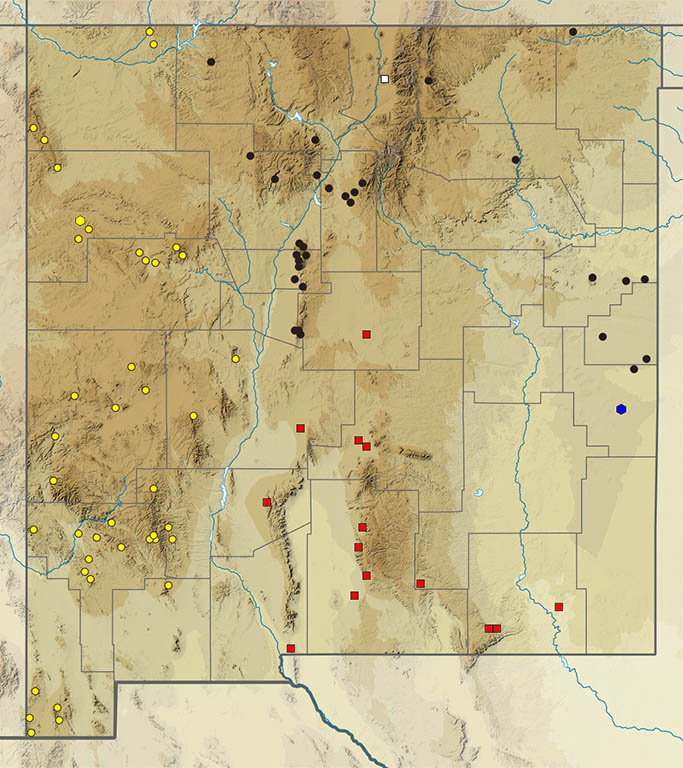
Megathymus ursus Poling Ursine Giant-skipper (updated June 13, 2023)
Description. The wingspan of this, our largest skipper, may approach four inches. The forewing upperside is dark brown with small subapical white spots and a submarginal band that varies from yellow to orange and from narrow to broad, to some extent depending on locality. Ursine Giant-Skipper has blue-violet suffusion on the underside. Like Yucca Giant-Skipper, there are two pale spots on the HW costa. The VFW repeats the pattern of the DFW, but the spots are paler. Range and Habitat. Megathymus ursus has a limited distribution in Arizona and southwestern New Mexico (counties: Gr,Hi,Si). Much of what is known about its distribution was originally learned by finding immatures in the field, digging up host yuccas, and waiting for adults to emerge. Life History. Females place eggs on yucca leaf tips, primarily of Yucca schottii and Yucca torreyi in New Mexico. Larvae crawl down and bore into the root. Flight. Adults fly in mid-summer, generally June 20 to August 7, but are rarely seen. Most sightings of males have been on prominent hilltops. Ursine Giant adults are not known to feed. Comments. Raymond VanBuskirk and Johdan Fine photographed a female as she went about the task of placing eggs (see below). Viola’s Giant-skipper was formerly considered a subspecies of Ursine (M. ursus violae), but Zhang et al. (2020) determined that violae is a species distinct from ursus. Wielgus et al (1972) described Megathymus ursus deserti from specimens collected in Maricopa County, AZ. In their recent DNA analysis, Zhang et al (2020) found that specimens of ursus from New Mexico’s Mogollon Rim country (counties: Gr,Si) in NM fell in with deserti while ursus specimens from south of that region (county: Hi) were nomino-typical ursus. Pelham (2023) recognized deserti as a valid subspecies, but for us, splitting three NM counties into two subspecies seems unnecessary.
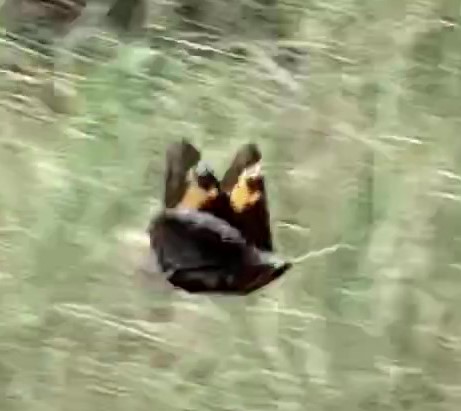
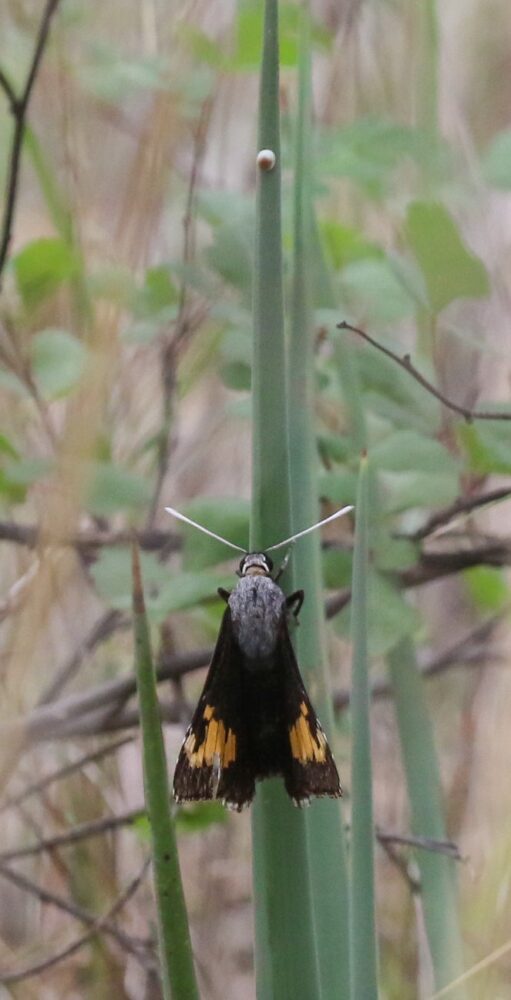
Ursine Giant-skipper female (Megathymus ursus) and e.g.; Clanton Canyon Tank, Peloncillo Mountains, Hidalgo Co., NM; August 7, 2020 (photo by Raymond VanBuskirk).

Occurrences of Ursus Giant-skipper (Megathymus ursus) in New Mexico.
Megathymus violae D. Stallings and Turner Viola’s Giant-skipper (updated June 14, 2023)
Description. As with Megathymus ursus, the wingspan of this, our largest skipper, may approach four inches. Viola’s Giant-Skipper looks very much like Ursine Giant-skipper, from which it was only recently distinguished as a separate species. The forewing upperside is dark brown with small subapical white spots and a submarginal band that varies from yellow to orange and from narrow (usually males) to broad (usually females). Typically, that band is slightly broader on violae than the band on ursus. The VHW is more heavily frosted in violae. Range and Habitat. Megathymus violae has a limited distribution in central and southeast New Mexico (counties: Be,DA,Ed,Ot,To,Va) plus west Texas, where it inhabits Transition and Upper Sonoran Zone areas with stands of the host. Life History. Females place eggs on yucca leaf tips, primarily of Yucca torreyi, but sometimes Yucca baccata. Larvae crawl down and bore into the root. Flight. In New Mexico, adults fly in early to middle summer, generally mid-June to mid-August 7, but are rarely seen. Most sightings of males have been on prominent hilltops. Viola’s Giant-skipper adults are not known to feed, but they do go to wet soil. Comments. Megathymus violae D. Stallings and Turner was described in 1956 from specimens collected at Carlsbad Caverns National Park (Ed).
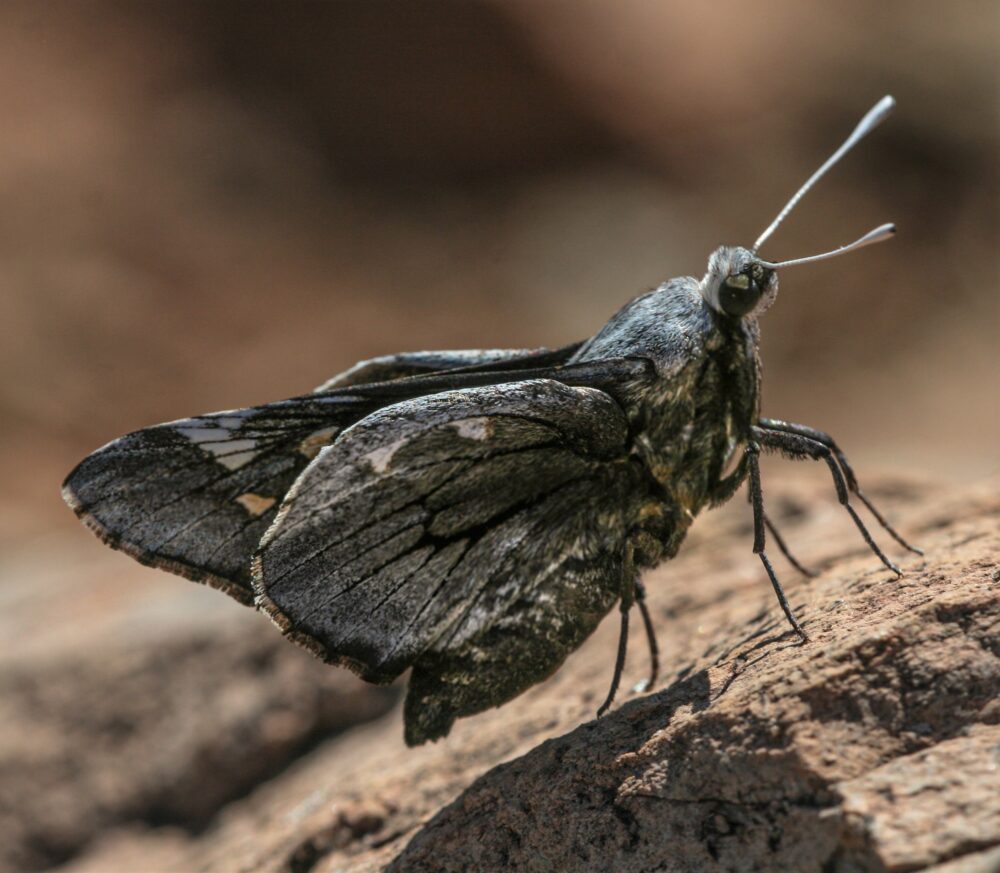
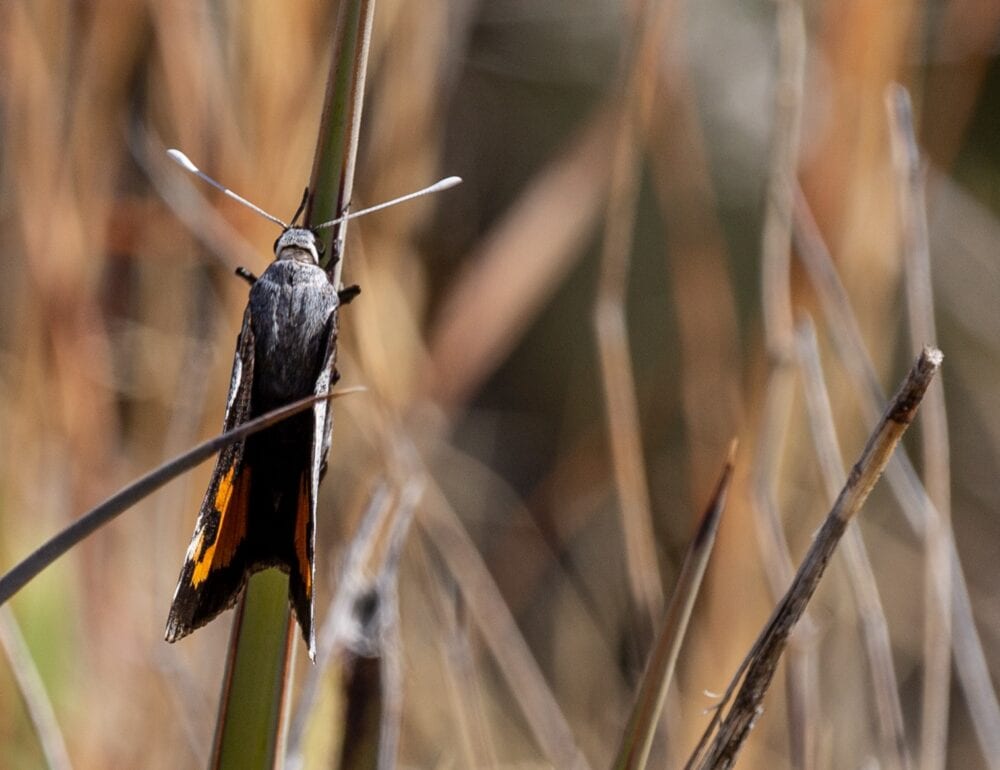
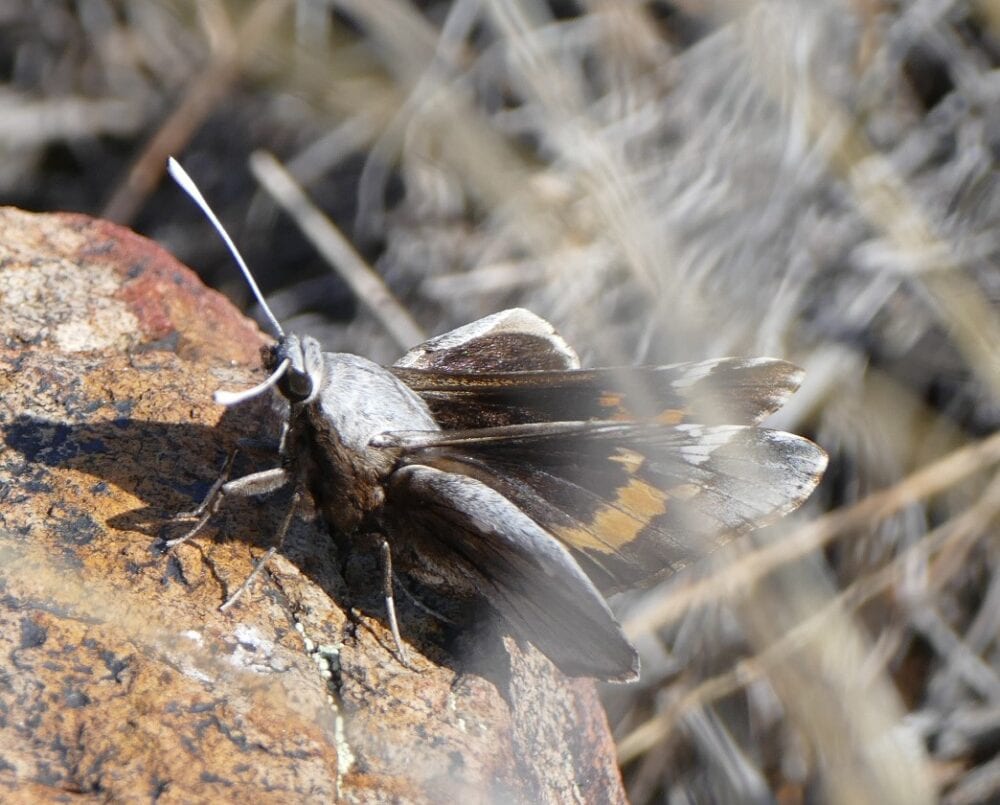

Megathymus streckeri (Skinner) Strecker’s Giant-skipper (updated June 15, 2023)
Description. Strecker’s Giant-skipper resembles the Yucca Giant-skipper on the upperside, but is bigger and has smaller submarginal spots on the FW. Those spots are white or yellowish. However, a quick look at the underside reveals the distinctive band of submarginal white or yellow spots on the HW (gray-brown ground color), lacking in Yucca G-S. Some forms of streckeri have the spot band reduced to a few spots, but those spots are always present and are lacking in yuccae. Range and Habitat. Megathymus streckeri inhabits the High Plains from Montana south to Texas and west across the southern Rockies to Utah and northern Arizona. In sub-montane New Mexico, generally 6000 to 7500′ elevation, it inhabits shrubby foothill canyons. Farther downslope on the plains, generally 3500 to 6500′ elevation, Strecker’s perches and patrols amid sprawling yucca flats. Life History. Yucca glauca, Yucca baileyi, and Yucca intermedia (Agavaceae) are known larval hosts. Females place eggs on the stout leaves. Scott (1992) noted oviposition on Yucca intermedia near Logan (Qu) and Toliver raised a female from a larva on Y. baileyi (Be). Larvae create silk-and-debris tents or galleries at the plant base. Flight. Megathymus streckeri completes one generation per year. Adults fly from April 6 to July 7, peaking in May on the plains and in June in the mountains. Adults perch on the ground or on low shrubs. When disturbed, they fly in agitated circles, often returning to a nearby perch. Comments. We have subspecies Megathymus streckeri streckeri around the edges of our mountains (counties: Be,Ci?,Li,MK,Ot,RA,Sv,SJ,SF,So,Ta,To?) and subspecies Megathymus streckeri leussleri W. Holland 1931 on our eastern plains (counties: Co,Cu,DB,Gu,Ha,Le,Qu,Ro,SM,To,Un).
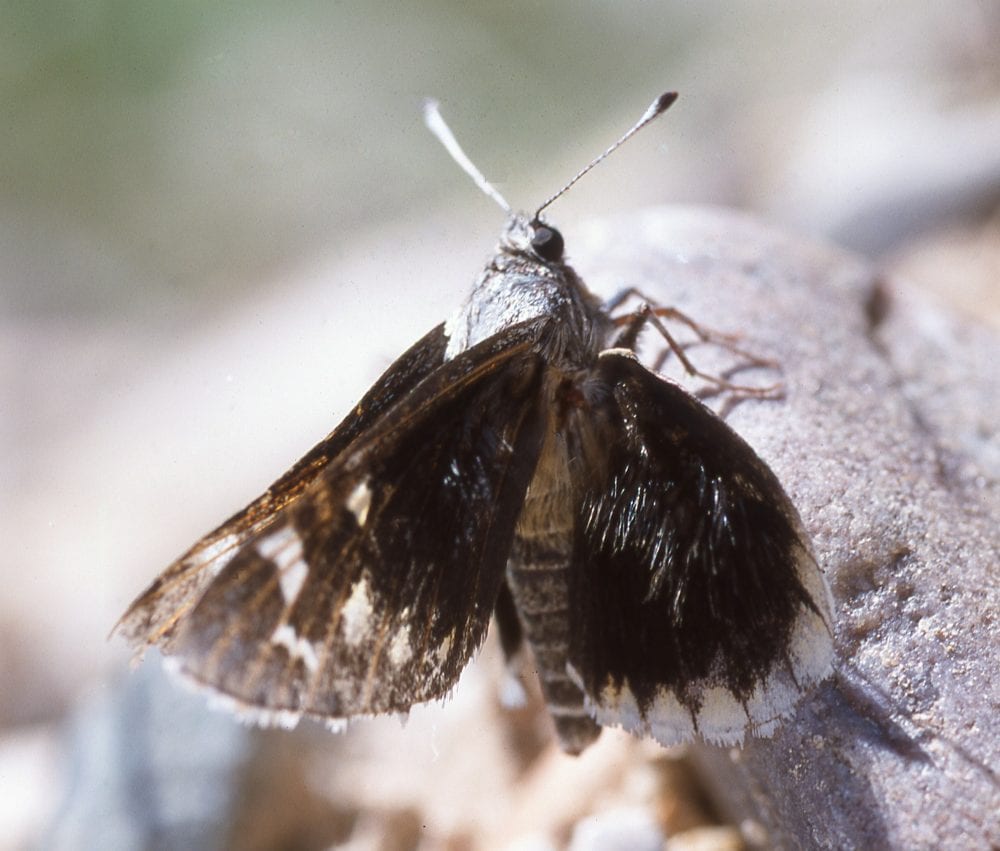
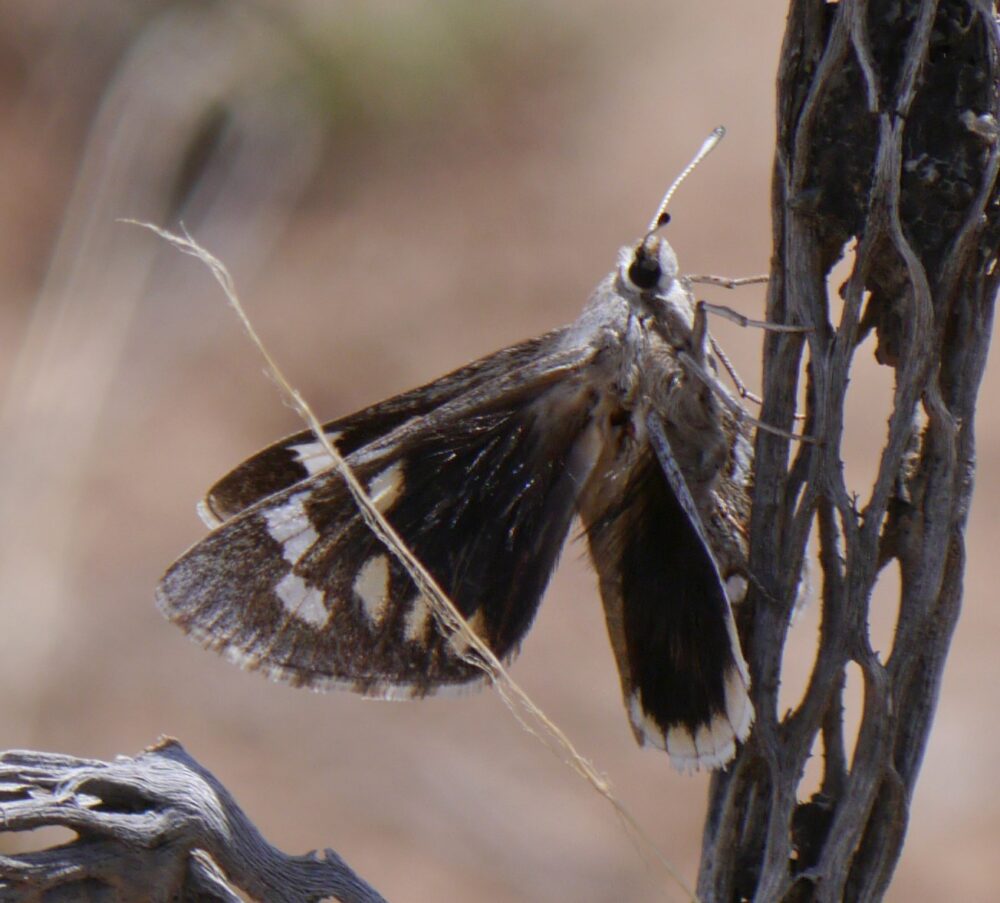
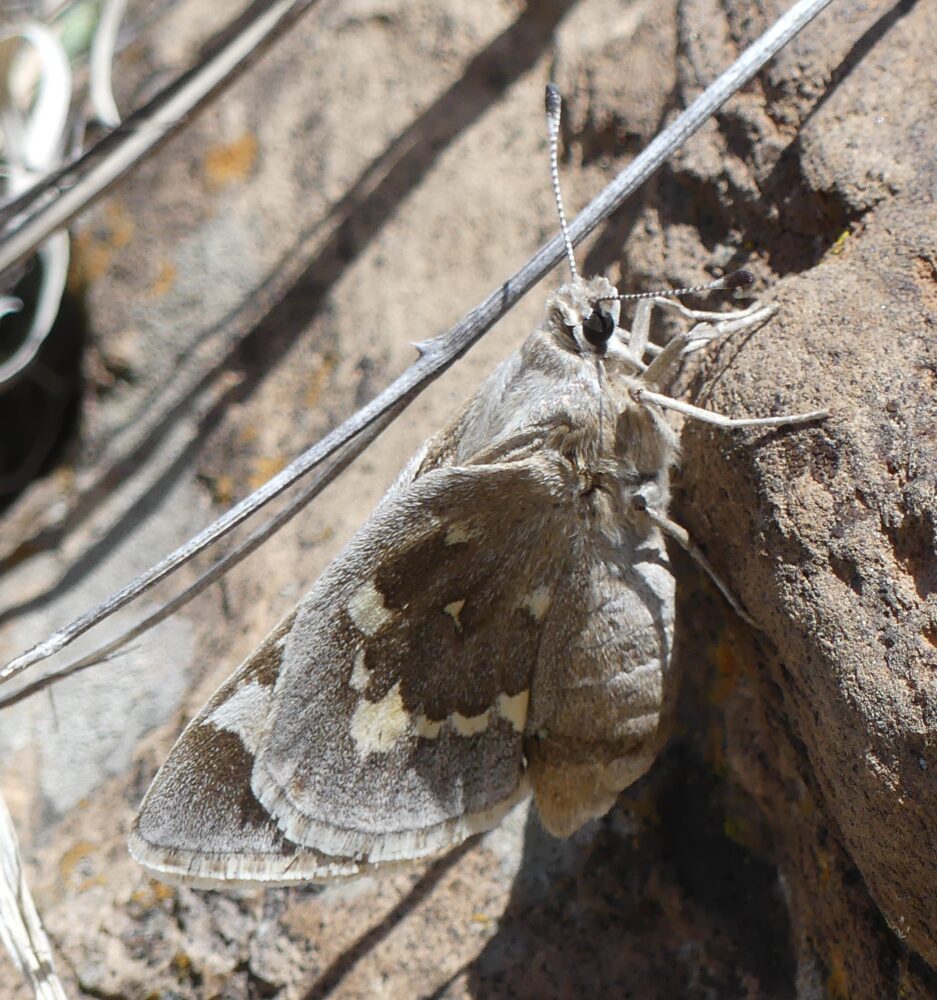
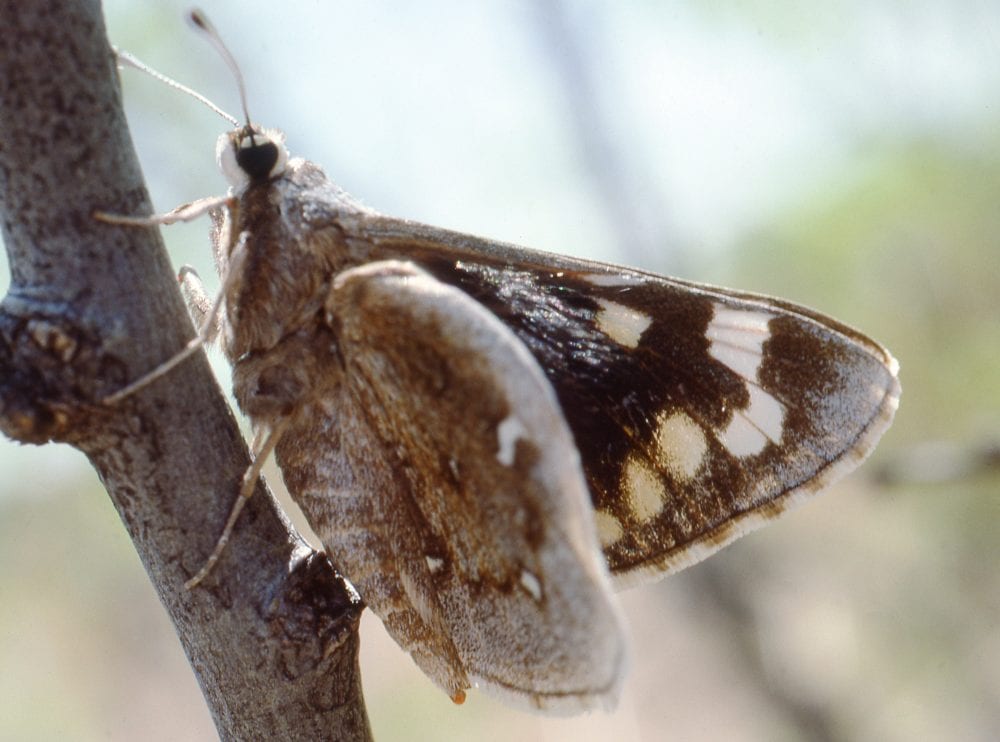
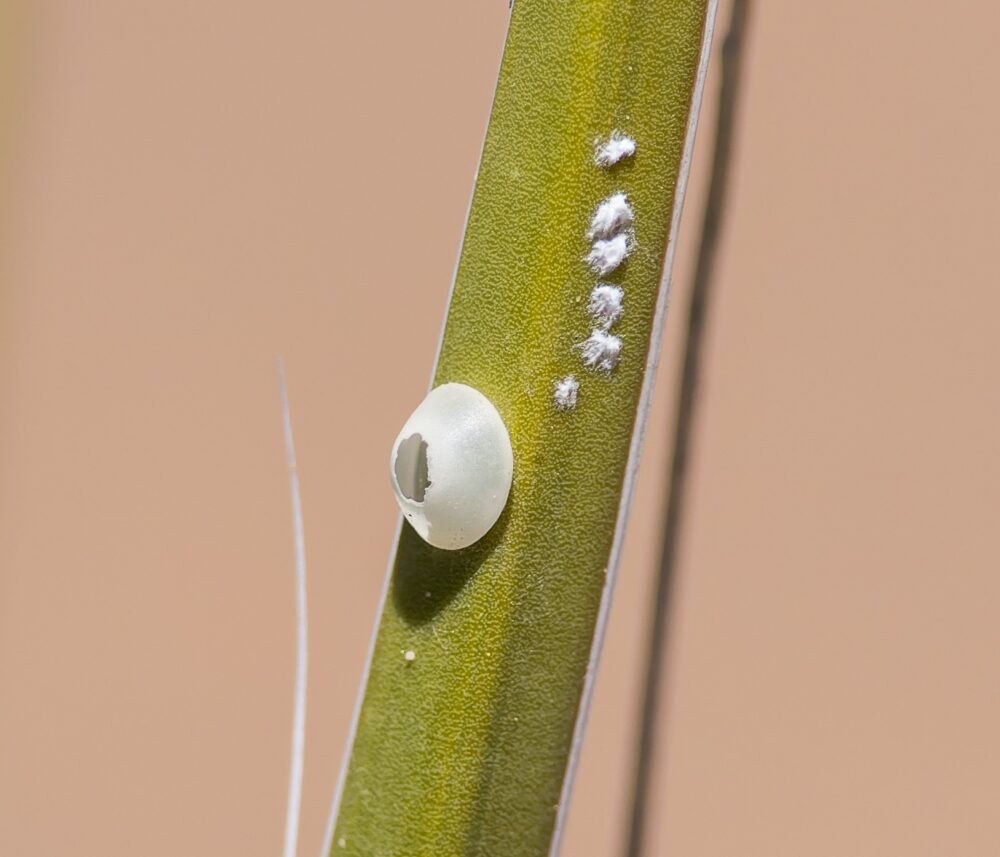


Comparison of Megathymus species found in NM. All images: left side dorsal, right side ventral. Males on left, females on right. A) Yucca Giant-skipper, M. yuccae male. B) Yucca Giant-skipper, M. yuccae female. C) Strecker’s Giant-skipper, M. streckeri male. D) Strecker’s Giant-skipper, M. streckeri. E) Ursus Giant-skipper (“The Bear”) M. ursus male. F) Ursus Giant-skipper (“The Bear”) M. ursus female. G) Viola’s Giant-skipper M. violae male. H) Viola’s Giant-skipper M. violae female. Photos courtesy of Andy Warren.
